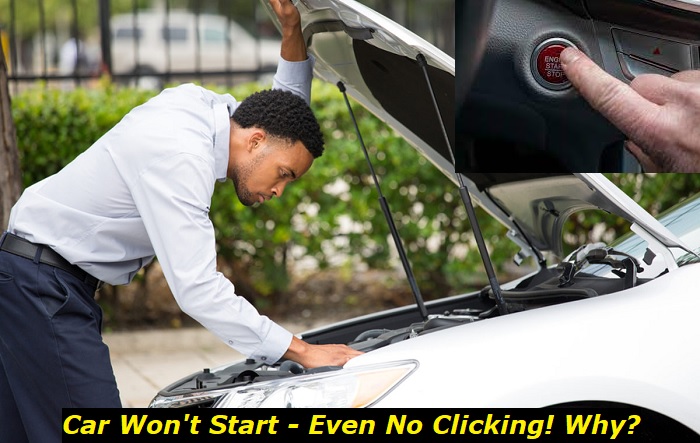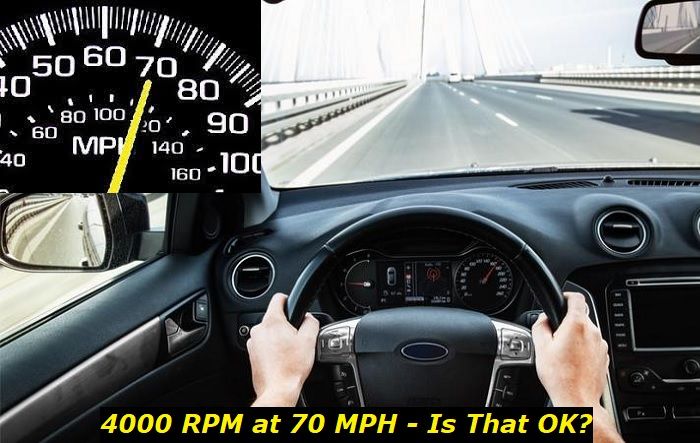When your vehicle doesn't start, this may be super stressful. Especially when you are away from home, near your work, or just in the parking lot of the local supermarket. Even worse - when you are in the middle of nowhere and just stopped on the roadside to have some rest and can't start the car after that.

When your car won't start and there is no clicking noise in the engine bay, the most likely reasons for this are the following:
- the 12V battery is dead;
- the ignition switch is failing;
- the wiring problems;
- starter motor failure;
- other rare issues.
Today, I will guide you through all of these issues after having spoken to several car mechanics and experienced drivers. We'll try to solve the problem without paying loads of money to mechanics for their inspection.
Let's get started!
Understanding the symptom that we are talking about - no start, no clicking
So, before we start troubleshooting our virtual car, I should make sure we are on the same page with you. I've already written a lot of other articles about the no-start issue but with other symptoms, so instead of wasting your time reading general information on this issue, you better find a more targeted article and solve your problem.
In this guide, I'll be looking at the issue that shows such symptoms:
- you can turn on the ignition or the accessory mode and see the welcome lights;
- you can also turn on the radio in your vehicle;
- once you push the start button or turn the key, there is just nothing;
- the engine doesn't even produce a clicking or cranking noise;
- your lights and radio may or may not dim when you are trying to start the engine;
- then you release the button or the key and try again but the problem is persistent.
So, in short, you just don't get any reaction from your engine to the attempts to start it. The lights and the radio may or may not work depending on the reason for this issue. But in most cases, they are working.
Although it's really hard to troubleshoot a car without looking at it and seeing all the symptoms, I will try to make some guesses. Here's what may be wrong!
1. Your battery is completely dead
The 12V battery in your car has one primary task: to crank the engine by supplying the starter motor with needed electricity. If the voltage of the battery is low because there is no juice, the cranking sound may be different - as though it's really hard for the starter motor to crank the engine. But it may still start.
But when the 12V battery is completely dead, it may not even crank the engine once. Anyway, you may see that your lights are working and the radio may be on. Lights and radio need much less power than the starter motor. Once you try to start the engine, the voltage of the battery falls under 8V and it means that the onboard equipment just turns off all the systems automatically to avoid any damage.
Also, the low battery may kill some fuses and eventually lead to even more problems than just a no-start issue.
2. Faulty ignition cylinder or push-start button
These issues may happen more often than you think. The lifespan of ignition cylinders depends on how they are used. If you are always in a hurry and abuse that little cylinder with hard and sharp moves, it may just fail one day and leave you without the possibility to start the engine.
Push-start buttons fail even more often. Again, their life expectancy is high but if you press them with all your power, they will fail eventually and need replacement.
With a push-button start, the situation is worse because it's really hard to imagine what you can do without replacing the faulty button.
But with an ignition cylinder, you have one option. You can try jump-starting your starter if you know something about how a car's electrical system works. I won't provide you with a step-by-step guideline because this process has a lot of danger in it. But it's still possible and you can try this if there is no other way out.
Of course, the replacement of the button or the cylinder is still the best idea to solve your problems. In most cases, it's better to just go to the dealership or to a trusted repair shop to have the issue solved.
3. Wiring issues
To start your vehicle, you need to send a signal from your ignition cylinder or push-start button directly to the starter motor. This is done through a series of wires that are connected to the ECU and the battery. But if one of the connections is lost or broken, you will not be able to send this signal and, as a result, the whole process will fail.
You may just have no reaction when you try to start the vehicle. And the reason for this is one failed wire or one tiny connection.
The worst thing about wiring problems is that locating these issues and repairing them is not easy. In most modern cars, you will just not be able to do anything without a good mechanic. They use special equipment to easily identify the location of the lost connection and to repair it within minutes.
Some cases may still need longer inspection and repair.
4. Starter motor failure
If the car feels completely dead and even doesn't click when you try to start it, it may mean that the starter motor passed away. It may be a solenoid or the entire starter motor - this is quite hard to locate and understand unless you have some experience as a car mechanic.
If you can check wires with a multimeter and make sure that the starter motor gets the signals but then nothing happens with it, you may be pretty sure that the problem is exactly with the starter. You may think that there is a fuse that breaks the starter circuit. But no, it's most often hardwired to the battery. There can be a wire-fuse but in case it fails, the signals and current will not get to the starter motor at all.
If the starter relay gets signals and you can prove it with your multimeter, the problem is with one of the components of the starter.
5. Other issues that can cause a no-start problem
There are about a hundred other issues that can cause a no-start and no-click problem with your car. I won't talk about all of them today. Instead, I will focus on what you should do to locate and deal with the problem.
Among some of the possible issues are the fuses, the battery terminals, the immobilizer, or other security systems that prevent the engine from starting. I can continue this list but this will most likely be of no purpose to you because locating these issues on your own is almost impossible.
What do you need to do when the car doesn't start and doesn't even click?
Given the lights and radio are working, you may try to do several things to get your vehicle back to life.
Here are just some of the most obvious ones:
- Push-start the car. If you have a vehicle with a manual transmission, you may want to push start it and see if it works that way. Ask someone to push the car, turn the ignition on, press the clutch pedal, turn the stick shift to the second gear, and slowly release the clutch until the car starts.
- Jumpstart the vehicle. Use a booster or another car and a set of jump-starting wires. Connect the wires to your battery, let it charge for about two-three minutes, and start the vehicle. If the problem is with the battery, you can start the car easily with a push-start procedure.
- Jump a starter solenoid. Most starter solenoids have two open connections that are represented by metal nuts. Take an isolated screwdriver and short those two nuts with the metal part of it. Be careful! Don't touch the metal part of the screwdriver! Before this you need to make sure the car is on the parking brake and the transmission is in Neutral.
- Use your multimeter. With the help of a simple and cheap multimeter, you can easily locate the issue. Check if the signals are coming to the starter motor. If not, the problem is most likely with the wiring, fuses, or ignition cylinder. If yes, the problem is with the starter.
- Call for help. If nothing helps in your situation, you may need to call a tow truck and deliver the car directly to the dealership or a trusted repair shop. This will help you quickly locate and repair the issue.
Final thoughts
The dead car is never a good experience. To avoid losing your time and sitting in the car playing with the key in the ignition cylinder, use tips from this article to quickly find the problem and maybe even solve it on your own. If you still can't do anything, it's time to call for help.
Also, don't bother even opening the hood of your car if you aren't sure you may at least locate the starter motor. In this case, just let mechanics do their job.
About the authors
The CarAraC research team is composed of seasoned auto mechanics and automotive industry professionals, including individuals with advanced degrees and certifications in their field. Our team members boast prestigious credentials, reflecting their extensive knowledge and skills. These qualifications include: IMI: Institute of the Motor Industry, ASE-Certified Master Automobile Technicians; Coventry University, Graduate of MA in Automotive Journalism; Politecnico di Torino, Italy, MS Automotive Engineering; Ss. Cyril and Methodius University in Skopje, Mechanical University in Skopje; TOC Automotive College; DHA Suffa University, Department of Mechanical Engineering






Add comment